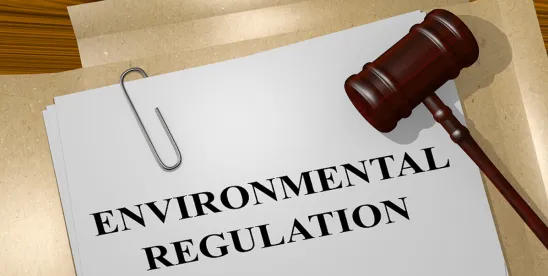The U.S. Court of Appeals for the Ninth Circuit recently found that the U.S. Environmental Protection Agency (EPA) failed to properly consider advances in wastewater treatment technology and ordered EPA to reconsider updating the effluent limitations guidelines (ELGs) for the following seven industrial categories: (1) Petroleum Refining; (2) Organic Chemicals, Plastics, and Synthetic Fibers Manufacturing; (3) Inorganic Chemical Manufacturing; (4) Fertilizer Manufacturing; (5) Pesticide Chemical Manufacturing; (6) Plastics Molding and Forming Facilities; and (7) Nonferrous Metals Manufacturing. If, upon reconsideration, EPA determines that the ELGs should be updated for some or all of these industrial categories, the result could be new ELG rulemaking, opportunities for covered industries to provide critical information to help ensure the rulemaking accounts for critical technical and economic information, and (ultimately) new ELG rules that could have substantial impacts on wastewater treatment requirements at covered facilities.
Background
The Clean Water Act (CWA) prohibits the discharge of any pollutant unless authorized. To satisfy this prohibition, dischargers typically obtain a National Pollutant Discharge Elimination System (NPDES) permit setting limits on discharges of pollutants. Those limits can be based on the amount of a pollutant the receiving water can handle without violating water quality standards and on the amount that can be discharged if the facility uses certain technology. This case involves the CWA’s technology-based limits.
Permit writers do not set technology-based limits in a vacuum. Instead, EPA must periodically establish ELGs for “classes and categories of point sources” based on, among other things, whether the facilities discharge to publicly owned treatment works or directly to waters of the United States. To date, EPA has promulgated ELGs for 59 industries (or “source categories”), including, for example, the steam electric power generating point source category (i.e., power plants)[1] and the meat and poultry products point source category.[2] The ELGs for the seven industrial categories mentioned above have not been revised for 30 years or more.
Under the CWA ELGs must be reviewed at least every five years and, if appropriate, revised pursuant to the procedures established by the statute. According to the Ninth Circuit, this and other periodic review obligations are intended to implement a system of continually tightening pollution controls by requiring EPA “to justify its regulations” in light of subsequent developments, including advancements in technology. In addition to these review requirements, EPA must publish a report that includes a schedule for annual review and revision of existing ELGs.
In EPA’s January 19, 2023 report – Program Plan 15, the report that is the focus of this litigation – EPA conducted a “Category Ranking Analysis” comparing discharge data across all 59 source categories to identify potential candidates for revision. EPA performed this analysis using data drawn from discharge monitoring reports (DMRs) that each direct discharger subject to a NPDES permit must report to EPA and then ranked each of the source categories from highest to lowest total pollutant load. EPA selected for further review eight categories, the seven highest ranking categories[3] plus the landfill category (which did not rank highly but, according to EPA, may be a major source of per- and polyfluoroalkyl substances (PFAS)). EPA determined that revisions to the ELGs for other categories are not warranted at this time.
A number of environmental groups[4] challenged EPA’s decision not to select seven industrial categories for ELG revision: (1) Petroleum Refining; (2) Organic Chemicals, Plastics, and Synthetic Fibers Manufacturing; (3) Inorganic Chemical Manufacturing; (4) Fertilizer Manufacturing; (5) Pesticide Chemical Manufacturing; (6) Plastics Molding and Forming Facilities; and (7) Nonferrous Metals Manufacturing.
Key Elements of Ninth Circuit Decision
The court agreed with EPA that EPA is not required to revise every older ELG, and that EPA had some discretion in carrying out its periodic review obligations. For example, EPA determined that it lacked the resources to revise every ELG. The court found this is generally a permissible basis to decline to initiate a rulemaking, and that EPA has broad discretion in this regard. However, the panel nonetheless concluded EPA acted in an arbitrary and capricious manner by refusing to revise the seven relevant ELGs, each of which has not been revised for 30 years or more. According to the court, EPA is not required to revise an ELG simply because it is out of date, but it must offer a reasoned justification for declining to do so. In ruling against EPA, the court made the following key conclusions:
EPA failed to properly consider advances in pollution control technology.
The court found that EPA’s Category Ranking Analysis failed to consider an important aspect of ELGs. If EPA is trying to identify the benefits of potential revision, then the difference between the standard set by the current ELG and the level at which a revised ELG is likely to be set is critical to the analysis. If an ELG has not been revised in a significant period of time, and technology in that industry has substantially improved, a revision could yield considerable benefits, even if the industry’s overall pollution load is comparatively low. The court found that without any consideration of technological developments in the Category Ranking Analysis, EPA could not have evaluated the benefits of further review or revision.
EPA failed to properly consider pretreatment standards applicable to indirect dischargers.
The CWA distinguishes between direct and indirect dischargers. Direct dischargers are point sources that emit pollutants directly into waterways, while indirect dischargers are point sources that send their pollutants to publicly owned treatment works (POTWs) for treatment prior to discharge. Indirect dischargers are subject to and must comply with pretreatment standards prior to sending their pollutants to POTWs.
The Category Ranking Analysis relied on DMR data reported to EPA by direct dischargers. The DMR data did not contain any information about indirect dischargers. Yet EPA relied on its Category Ranking Analysis in deciding not to review the pretreatment standards for certain categories. The court found this approach arbitrary and capricious.
EPA failed to properly consider information relating to pollutants not currently covered by the applicable ELGs.
The environmental groups also argued that EPA’s analysis did not consider unregulated pollutants. In particular, the ELGs for the seven industrial categories do not address nutrient pollution, even though EPA has recognized nutrient pollution is a significant environmental challenge. For example, they noted that only 9 of the 331 facilities in the Petroleum Refining category reported data for total nitrogen pollution. According to the environmental groups, this skewed the Category Ranking Analysis because it meant discharges of unregulated pollutants were, for the most part, not reflected in a category’s overall pollution load. The court agreed. The court found that if the imposition of ELGs for nutrient pollution would produce significant pollution reduction benefits for the seven categories, then that fact bears directly on EPA’s decision to prioritize revision of certain ELGs over others.
Based in part on the key conclusions noted above, the Ninth Circuit remanded EPA’s decision for reconsideration.
Implications
If EPA, upon reconsideration, decides to engage in rulemaking to revise the ELGs for the (1) Petroleum Refining; (2) Organic Chemicals, Plastics, and Synthetic Fibers Manufacturing; (3) Inorganic Chemical Manufacturing; (4) Fertilizer Manufacturing; (5) Pesticide Chemical Manufacturing; (6) Plastics Molding and Forming Facilities; or (7) Nonferrous Metals Manufacturing industries, it could have substantial impacts on those industries. Because an ELG rulemaking is based, in part, on the performance and availability of various wastewater treatment technologies, and the economic achievability of implementing that technology across the industry. The rulemaking is often a data-driven process in which companies may want to submit comments to inform the rulemaking and may be subject to either voluntary or mandatory information collection requests from EPA. If EPA ultimately promulgates more stringent ELGs, the rulemaking will likely require substantial investments in wastewater treatment technologies to comply with the new limits.
[1] EPA promulgated updated ELGs for the steam electric power generating point source category in 2015, 2020, and 2024. See, e.g., 89 Fed. Reg. 40,198 (May 9, 2024).
[2] EPA proposed modifications to the ELGS for the meat and poultry products point source category in 2024. 89 Fed. Reg. 4,474 (Jan. 23, 2024).
[3] Metal Products and Machinery, Battery Manufacturing, Explosives Manufacturing, Canned and Preserved Seafood Processing, Paint Formulating, Sugar Processing, and Soap and Detergent Manufacturing.
[4] Waterkeeper Alliance, Center for Biological Diversity, Clean Water Action, Food & Water Watch, Healthy Gulf, Environment America, Surfrider Foundation, Bayou City Waterkeeper, Black Warrior Riverkeeper, San Antonio Bay Estuarine Waterkeeper, Tennessee Riverkeeper, and San Francisco Baykeeper.





 />i
/>i

